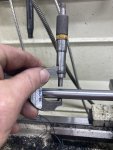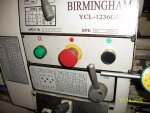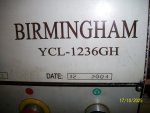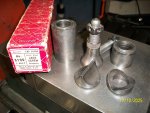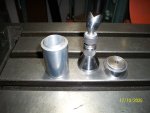Runs With Scissors
Well-known member
Equipment
L2501 TLB , Grappel, Brush Hog, Box Blade, Ballast box, Forks, Tiller, PH digger
Well there I am working on the my Chi-Com mill, back story posted below.
https://www.orangetractortalks.com/...little-help-from-the-electronics-gurus.77082/
I am moving along quite well with the X and Y axis.
Pretty simple and straight forward job. Make a couple of simple bracket, drilll, tap and install.
I decide to put the X axis on the stern, where it will be out of the way.

I decide to put the Y axis on the starboard side, for no real particular reason, other than the table is already sitting in an “advantageous spot” so I won’t have to move anything.

As my granddaughter would say……………….“Easy peezy, lemon squezzy”
Now I have to work on the Z axis.
Long story short, I can’t see an “obvious place” to mount the “magnetic tape” (Oh yea, and I decided to give this style of DRO instead of the traditional “glass scales” a whirl….it’s basically a $150 dollar gamble).
So after some head scratching I remember that, many, many moons ago, I removed the “Z axis measuring thing” .
And I be damned if when I opened the built in cabinet, there it was.
That threaded rod used to go in the area there the DRO display is currently, was used some sort of “Z axis stopper”, but now I figure if I “cock it” to the side a little (as pictured) I could “Jerry rig” (or is it Jury rig?) something up.

It's off to the “drawing board”…………...
Well the smoke starts pouring out of my ears, and I come up with a “plan"
I am going to make a piece nearly identical to the current “threaded rod” EXCEPT
Instead of “threads”, I am going to mill a flat spot and use that to “glue” the magnetic tape to, then make a custom bracket to hold the sensor head.
So the very first thing I have to do is measure how long i need to make it.
So I run the quill down and lock it in place.
Its about 5.5 inchs.
Then I let it back up, and repeat…….again about 5.5 ish inches (remember this )
)
So now I take a few measurements and measure the thread pitch of the nut that holds it on.
PERFECT……It’s a standard 5/8-18, so I can use the original “thin nut”…..saving me a bit of time/effort

Off to the scrap pile.
I find this ‘remnant” that looks perfect.
So I chuck it up, and use my new NOGA indicator holder to check the run out
Whoooo, Hooooooo………..The UPS fairy just dropped it off 2 days ago and I am dying to use it!!!!!!!
From what I gather it is the “latest and greatest” becasue it has both a “bottom adjuster” and a “top adjuster”



So I chuck up the piece, check it for run out and start to turn it down to size.
I finally get it to "pretty close" to the final dimensions.
Now I just gotta turn the threaded part…
So I get it all set up with the “fish tail” check and “double checK” that I have the machine set properly.
I get ready to do my “scratch pass”……
I flip the handle and
BAM………CRASH!!!!!!!!!!!!….BOOM!!!!!!!!!!!!!!!
I basically shit my pants………………I jam the “emergency stop” button so hard that I hurt my palm.
Mother____her…….!!!!!!! Gosh Damn it all to hell………Sum bitch……..'………..
I can’t recall with total clarity, but I crashed that dirty rotten mo——————er smack dab into my new chuck and
here is the end result.

and here is the tool holder…..
.

Feeling like a “total dumbass”, very pissed off, and needing to change my britches, I ask myself WTF just happened………….I shut the lights off, and pour a "cold one"………….DAMN IT………….
https://www.orangetractortalks.com/...little-help-from-the-electronics-gurus.77082/
I am moving along quite well with the X and Y axis.
Pretty simple and straight forward job. Make a couple of simple bracket, drilll, tap and install.
I decide to put the X axis on the stern, where it will be out of the way.
I decide to put the Y axis on the starboard side, for no real particular reason, other than the table is already sitting in an “advantageous spot” so I won’t have to move anything.
As my granddaughter would say……………….“Easy peezy, lemon squezzy”
Now I have to work on the Z axis.
Long story short, I can’t see an “obvious place” to mount the “magnetic tape” (Oh yea, and I decided to give this style of DRO instead of the traditional “glass scales” a whirl….it’s basically a $150 dollar gamble).
So after some head scratching I remember that, many, many moons ago, I removed the “Z axis measuring thing” .
And I be damned if when I opened the built in cabinet, there it was.
That threaded rod used to go in the area there the DRO display is currently, was used some sort of “Z axis stopper”, but now I figure if I “cock it” to the side a little (as pictured) I could “Jerry rig” (or is it Jury rig?) something up.
It's off to the “drawing board”…………...
Well the smoke starts pouring out of my ears, and I come up with a “plan"
I am going to make a piece nearly identical to the current “threaded rod” EXCEPT
Instead of “threads”, I am going to mill a flat spot and use that to “glue” the magnetic tape to, then make a custom bracket to hold the sensor head.
So the very first thing I have to do is measure how long i need to make it.
So I run the quill down and lock it in place.
Its about 5.5 inchs.
Then I let it back up, and repeat…….again about 5.5 ish inches (remember this
So now I take a few measurements and measure the thread pitch of the nut that holds it on.
PERFECT……It’s a standard 5/8-18, so I can use the original “thin nut”…..saving me a bit of time/effort
Off to the scrap pile.
I find this ‘remnant” that looks perfect.
So I chuck it up, and use my new NOGA indicator holder to check the run out
Whoooo, Hooooooo………..The UPS fairy just dropped it off 2 days ago and I am dying to use it!!!!!!!
From what I gather it is the “latest and greatest” becasue it has both a “bottom adjuster” and a “top adjuster”
So I chuck up the piece, check it for run out and start to turn it down to size.
I finally get it to "pretty close" to the final dimensions.
Now I just gotta turn the threaded part…
So I get it all set up with the “fish tail” check and “double checK” that I have the machine set properly.
I get ready to do my “scratch pass”……
I flip the handle and
BAM………CRASH!!!!!!!!!!!!….BOOM!!!!!!!!!!!!!!!
I basically shit my pants………………I jam the “emergency stop” button so hard that I hurt my palm.
Mother____her…….!!!!!!! Gosh Damn it all to hell………Sum bitch……..'………..
I can’t recall with total clarity, but I crashed that dirty rotten mo——————er smack dab into my new chuck and
here is the end result.
and here is the tool holder…..
.
Feeling like a “total dumbass”, very pissed off, and needing to change my britches, I ask myself WTF just happened………….I shut the lights off, and pour a "cold one"………….DAMN IT………….
Last edited:


